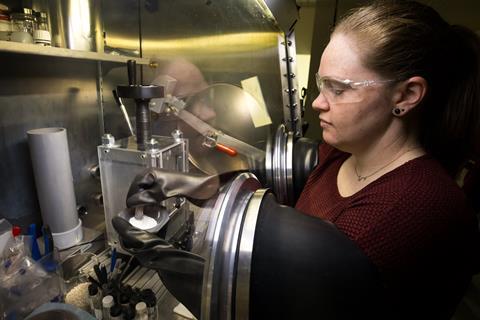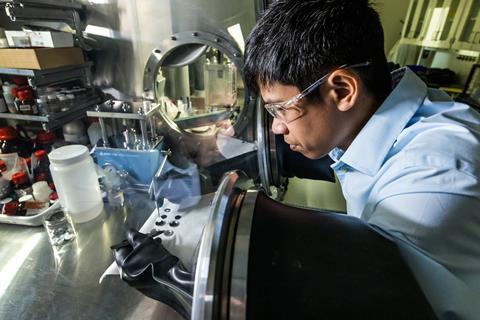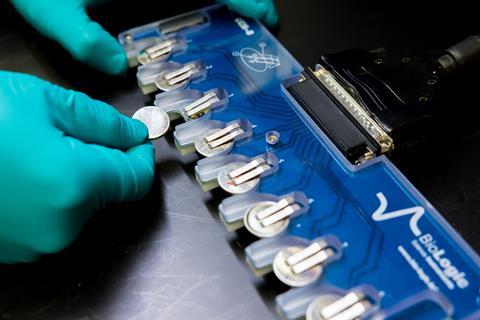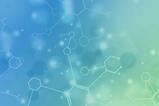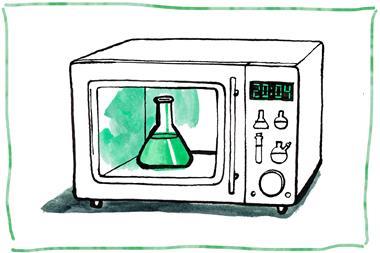Microsoft and the US Department of Energy’s Pacific Northwest National Laboratory (PNNL) are collaborating to demonstrate the power of combining artificial intelligence (AI) with high-performance computing to accelerate innovation. In less than 9 months, the teams discovered and synthesized a new material for resource-efficient batteries.
The discovery of a promising new battery material by researchers at Microsoft and PNNL demonstrates the power of combining artificial intelligence (AI) with high-performance computing to accelerate innovation. The team’s computational approach used digital simulations and AI models to analyse over 32 million materials in under a week to identify a new solid-state electrolyte with potential use in sustainable energy storage. Key to the project was Microsoft’s Azure Quantum Elements platform, which dramatically speeds up the process of carrying out scientific research.
‘Our goal is to compress the next 250 years of chemistry and materials science progress into the next 25,’ said Microsoft CEO Satya Nadella. Azure Quantum Elements uses world-leading high-performance computing in combination with AI tools to assist scientists as they probe complex problems.
According to Nathan Baker, product leader for Azure Quantum Elements, Microsoft believes its computing prowess can help tackle some of the biggest challenges facing the planet. ‘Whether it’s pollution, climate change, food scarcity, or disease – all of those problems likely have their solutions in the space of chemistry and material science,’ he explains. ‘The traditional approaches of understanding these systems are very powerful, but they’re slow – we need a digital transformation to speed up the way that we look at these systems.’
Learn how the next generation of computational tools is ushering in a new era of scientific discovery in our live Chemistry World webinar with Nathan Baker on 7 March 2024.
The team at Microsoft says that its Azure Quantum Elements platform addresses four fundamental problems that have long hindered computational chemists. The first of these relates to productivity and the amount of time scientists spend grappling with complicated computational programs and infrastructure. The other three are technical challenges surrounding the speed, scale, and accuracy of calculations.
Ramping up productivity
Azure Quantum Elements tackles the productivity challenge in two ways. The first is by integrating a wide range of chemistry software into a single cloud-based platform. ‘Computational chemistry tools and the computational infrastructure needed to run those tools – they’re hard to assemble. They’re hard to maintain. They’re hard to upgrade. They’re hard to optimise, ‘ notes Baker. ‘What we’ve done with Azure Quantum Elements is designed a cluster for every chemist – we call it a chemistry supercomputer – to address these challenges.’
we’re standing at the precipice of a paradigm shift in computing as it relates to advancing scientific discovery
Brian Abrahamson, chief digital officer at PNNL
The idea is to make all of the infrastructure that computational chemists need to carry out their work as easy to access as possible. ‘That means the high-speed networking, the high-speed storage, the virtual machines that give you high-speed computing, whether they’re CPU or GPU,’ says Baker. ‘And then most importantly, the packages and the workflows that sit on top of those – they’ve all been optimised for this platform and they’re all ready to go when the chemist logs in.’
The second way that Azure Quantum Elements simplifies computational research is by improving the user experience with its innovative ‘Copilot in Azure Quantum’ – an AI-powered assistant to help researchers use the platform. The Copilot is trained on large language models and helps users of Azure Quantum Elements make the most of its capabilities in an intuitive way.
‘Even if you’re an experienced computational chemist, jumping into a new environment, applying a new workflow manager or experimenting with a new quantum chemistry code is hard if you’ve never used it before,’ explains Baker. ‘The syntax for these systems is arcane, and a human could spend a lot of time in the user manual or on the web trying to figure it out. It’s amazing what Copilot can do to remove barriers for transitioning to new systems.’
Addressing technical challenges
Azure Quantum Elements improves the speed, scale, and accuracy of calculations in several ways. One is sheer power; as a cloud-based platform, Azure Quantum Elements enables high-performance computing calculations to be carried out to a degree that would be almost impossible with an on-premises system, notes Baker. Additionally, the integration of AI into the platform further increases the rate with which Azure Quantum Elements can find answers to complex problems – for example, questions about chemicals’ properties and behaviours.
‘In some cases, rather than running a traditional physics-based simulation using high-performance computing to get that answer, you can call an AI model,’ says Baker. ‘For some steps in the simulation, you’re already seeing a tremendous speed up, because you’re taking what could be an exceedingly long simulation and replacing it with a very fast AI model inference,’ he adds.
traditional approaches would have taken 20 years and we accomplished it in less than a week
Nathan Baker, product leader for Azure Quantum Elements
Where simulations can’t be directly replaced with AI inferences, Azure Quantum Elements can still make use of machine learning to speed up the process. ‘When the simulation is providing insights beyond just a particular property, we want to make sure that that value is still available to the scientist. So we use AI for that in the form of machine learning forcefields,’ says Baker. ‘These can dramatically speed up the calculation compared to, say, doing a quantum mechanical evaluation in each step. But you still get the accuracy and the insight that you would obtain from a traditional physics-based approach.’
Microsoft built Azure Quantum Elements with connectivity into quantum computing systems in mind. While quantum computers are still in a developmental stage, these tools offer the potential to carry out fully quantum mechanical calculations of chemical systems without making the approximations that are currently required with classical computers, which would radically improve their accuracy.
‘There’s a lot of value in building into the platform the tools that scientists can use now to familiarise themselves with quantum computing, and can use in the future to take advantage of powerful quantum supercomputers when they arise,’ notes Baker.
Sustainable energy storage
To demonstrate the power of the Azure Quantum Elements platform, the Microsoft team partnered with scientists from PNNL to identify electrolytes that are more sustainable than those used in current lithium-based batteries.

‘Lithium and other strategic elements used in these batteries are finite resources with limited and geographically concentrated supplies,’ says PNNL materials scientist Vijay Murugesan. ‘One of the main thrusts of our work at PNNL has been identifying new materials for increased energy storage needs of the future; ones made with sustainable materials that conserve and protect the Earth’s limited resources.’
The project used Azure Quantum Elements to screen 32.6 million candidate materials that were generated by substituting atoms in known crystal structures with a range of selected elements. As described in the latest publication, by using AI models trained on millions of data points from materials simulations, Azure Quantum Elements carried out the necessary computational calculations to predict the materials properties over a thousand times faster than would be possible using a traditional DFT -based approach.
The team first used Azure Quantum Elements to narrow the search space from 32.6 million to approximately 500,000 candidate materials with suitable stability. AI models were then used to predict physical properties like redox potential and band gap in order to reduce the number of candidates to around 800, before molecular dynamics simulations whittled these down to 150 possible materials. Finally, by incorporating practical considerations such as the availability and cost of necessary starting materials , the system produced 18 top candidates.
‘If you look at the computation time required [for this screening process], traditional approaches would have taken 20 years and we accomplished it in less than a week,’ notes Baker.
At this point the PNNL group narrowed the list further based on its experience working with these types of materials in the lab and applying them in battery technology. They then synthesised the top candidate – a form of lithium–sodium–yttrium chloride – in a solid-state reaction. ‘We selected suitable raw materials and mixed them with mortar and pestle, produced a pellet, and finally melted it under inert atmosphere at around 500°C,’ explains Murugesan. ‘We confirmed the structure of this new material using X-ray diffraction and analysed its ionic conductivity.’ The final material contains 70% less lithium than other industry-leading solid-state electrolytes and possesses clear structural features that appear to explain its exceptional levels of conductivity.
The PNNL team then tested the material in a working battery, at high pressure across a range of temperatures. While the electrolyte is not quite as effective as current commercial materials, the team believes that it can be developed further. The material’s structure also offers important lessons on how to optimise conductivity while minimising the use of lithium. More importantly, the project illustrates how high-performance computing and AI can be used to find practical leads for solving real-world problems. Murugesan notes that the project ‘was remarkable for the speed at which it led to identification of a new candidate material’.
‘We’re standing at the precipice of a paradigm shift in computing as it relates to advancing scientific discovery,’ says PNNL chief digital officer Brian Abrahamson. ‘This convergence between artificial intelligence and high-performance computing and the cloud – those elements coming together to introduce fundamentally new ways to accelerate discovery is a marked shift.’
According to Abrahamson, this is a shift that the scientific world hasn’t seen since the dawn of supercomputing. ‘For us, it’s helping us to tackle fundamental challenges in chemistry, which is the science that’s opening up new avenues for discovery to solve some of the world’s great scientific challenges,’ he adds.
Download our free whitepaper exploring the recent break-throughs in molecular simulation, the latest advances in HPC and AI and how Azure Quantum Elements can help you make progress today
References
Chen et al. arXiv:2401.04070v1 [cond-mat.mtrl-sci], 8 Jan 2024. DOI: 10.48550/arXiv.2401.04070



